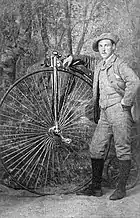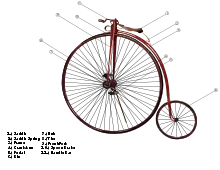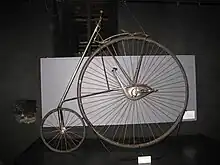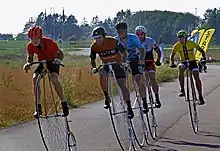Penny-farthing
The penny-farthing, also known as a high wheel, high wheeler or ordinary, is an early type of bicycle.[1] It was popular in the 1870s and 1880s, with its large front wheel providing high speeds, owing to it travelling a large distance for every rotation of the legs, and comfort, because the large wheel provided greater shock absorption.

It became obsolete in the late 1880s with the development of modern bicycles, which provided similar speed, via a chain-driven gear train, and comfort, from the use of pneumatic tires. They were marketed as "safety bicycles" because of the greater ease of mounting and dismounting, the reduced danger of falling, and the reduced height to fall, in comparison to penny-farthings.[2][3]
The name came from the British penny and farthing coins, the penny being much larger than the farthing, so that the side view of the bicycle resembles a larger penny (the front wheel) leading a smaller farthing (the rear wheel).[4] Although the name "penny-farthing" is now the most common, it was probably not used until the machines had been almost superseded. The first recorded print reference is from 1891 in Bicycling News.[5] For most of their reign, they were simply known as "bicycles", and were the first machines to be so called, although they were not the first two-wheeled, pedaled vehicles.[6] In the late 1890s, the name "ordinary" began to be used, to distinguish them from the emerging safety bicycles,[7] and that term, along with "hi-wheel" and variants, are preferred by many modern enthusiasts.[8][9]
Following the popularity of the boneshaker, Eugène Meyer, a Frenchman, invented the high-wheeler bicycle design in 1869 and fashioned the wire-spoke tension wheel.[10] Around 1870 English inventor James Starley, described as the father of the bicycle industry, and others, began producing bicycles based on the French boneshaker but with front wheels of increasing size,[4] because larger front wheels, up to 5 feet (152 cm) in diameter, enabled higher speeds on bicycles limited to direct-drive.[3][4][11][12][13] In 1878, Albert Pope began manufacturing the Columbia bicycle outside Boston, starting their two-decade heyday in America.[4]
Although the trend was short-lived, the penny-farthing became a symbol of the late Victorian era. Its popularity also coincided with the birth of cycling as a sport.[4]
History
Origins and development
%252C_cover_-_BL.jpg.webp)
Eugène Meyer of Paris is now regarded as the father of the high bicycle[10] by the International Cycling History Conference in place of James Starley. Meyer patented a wire-spoke tension wheel with individually adjustable spokes in 1869.[4] They were called "spider" wheels in Britain when introduced there.[4] Meyer produced a classic high bicycle design during the 1880s.
James Starley in Coventry added the tangent spokes[4] and the mounting step to his famous bicycle named "Ariel". He is regarded as the father of the British cycling industry. Ball bearings, solid rubber tires and hollow-section steel frames became standard, reducing weight and making the ride much smoother.[4]
Penny-farthing bicycles are dangerous because of the risk of headers (taking a fall over the handlebars head-first). Makers developed "moustache" handlebars, allowing the rider's knees to clear them,[14] "Whatton" handlebars that wrapped around behind the legs,[15] and ultimately (though too late, after development of the safety bicycle), the American "Eagle" and "Star" bicycles, whose large and small wheels were reversed.[16][17] This prevented headers but left the danger of being thrown backwards when riding uphill. Other attempts included moving the seat rearward and driving the wheel by levers or treadles, as in the "Xtraordinary" and "Facile",[18][19] or gears, by chain as in the "Kangaroo" or at the hub, as in the "Crypto";[16] another option was to move the seat well back, as in the "Rational".[16][20]
Even so, bicycling remained the province of the urban well-to-do, and mainly men, until the 1890s,[21] and was a salient example of conspicuous consumption.[22]
Attributes

The penny-farthing used a larger wheel than the velocipede, thus giving higher speeds on all but the steepest hills. In addition, the large wheel gave a smoother ride,[23] important before the invention of pneumatic tires.[24]
Although the high riding position seems daunting to some, mounting can be learned on a lower velocipede. Once the technique is mastered, a high wheeler can be mounted and dismounted easily on flat ground and some hills.
An attribute of the penny-farthing is that the rider sits high and nearly over the front axle. When the wheel strikes rocks and ruts, or under hard braking, the rider can be pitched forward off the bicycle head-first. Headers were relatively common and a significant, sometimes fatal, hazard. Riders coasting down hills often took their feet off the pedals and put them over the tops of the handlebars, so they would be pitched off feet-first instead of head-first.[15]
Penny-farthing bicycles often used similar materials and construction as earlier velocipedes: cast iron frames, solid rubber tires, and plain bearings for pedals, steering, and wheels. They were often quite durable and required little service. For example, when cyclist Thomas Stevens rode around the world in the 1880s, he reported only one significant mechanical problem in over 20,000 kilometres (12,000 mi), caused when the local military confiscated his bicycle and damaged the front wheel.
End of an era
The well-known dangers of the penny-farthing[25] were, for the time of its prominence, outweighed by its strengths. While it was a difficult, dangerous machine, it was simpler, lighter, and faster than the safer velocipedes of the time. Two new developments changed this situation, and led to the rise of the safety bicycle. The first was the chain drive, originally used on tricycles, allowing a gear ratio to be chosen independent of the wheel size. The second was the pneumatic bicycle tire, allowing smaller wheels to provide a smooth ride.

The nephew of one of the men responsible for popularity of the penny-farthing was largely responsible for its demise. James Starley had built the Ariel (spirit of the air)[26] high-wheeler in 1870; but this was a time of innovation, and when chain drives were upgraded so that each link had a small roller, higher and higher speeds became possible without the need for a large front wheel.
In 1885, Starley's nephew John Kemp Starley took these new developments to launch the modern bicycle, the Rover safety bicycle, so-called because the rider, seated much lower and farther behind the front wheel contact point, was less prone to a header.[4][27]
In 1888, when John Dunlop re-invented the pneumatic tire for his son's tricycle, the high wheel was made obsolete. The comfortable ride once found only on tall wheels could now be enjoyed on smaller chain-driven bicycles. By 1893, high-wheelers were no longer being produced.[3] Use lingered into the 1920s in track cycling until racing safety bicycles were adequately designed.
Modern usage

Today, enthusiasts ride restored penny-farthings, and a few manufacturers build new ones with modern materials.[28] One of these manufacturers is UDC Penny Farthings, the largest penny-farthing manufacturer in the United Kingdom. The manufacturer recorded record sales of penny-farthings in 2020 during the COVID-19 lockdown.[29]
The Penny Farthing Club is a cycling club that was founded in 2013 by Neil Laughton. The club offers rider training, bike tours of London and other UK cities, and hosts club events such as penny-farthing polo.[30]
Characteristics

The penny-farthing is a direct-drive bicycle, meaning the cranks and pedals are fixed directly to the hub. Instead of using gears to multiply the revolutions of the pedals, the driven wheel is enlarged to be close to the rider's inseam, to increase the maximum speed. This shifts the rider nearly on top of the wheel and makes it impossible for the rider to reach the ground while sitting on the seat.[4]
Construction
The frame is a single tube following the circumference of the front wheel, then diverting to a trailing wheel. A mounting peg is above the rear wheel. The front wheel is in a rigid fork with little if any trail. A spoon brake is usually fitted on the fork crown, operated by a lever from one of the handlebars. The bars are usually mustache shaped, dropping from the level of the headset. The saddle mounts on the frame less than 18 inches (46 cm) behind the headset.
One particular model, made by Pope Manufacturing Company in 1886, weighs 36 pounds (16 kg), has a 60-spoke 53-inch (130 cm) front wheel and a 20-spoke 18-inch (46 cm) rear wheel. It is fitted with solid rubber tires. The rims, frame, fork, and handlebars are made from hollow, steel tubing. The steel axles are mounted in adjustable ball bearings. The leather saddle is suspended by springs.[31]
Another model, made by Humber and Co., Ltd., of Beeston, Nottingham, weighs only 24 pounds (11 kg), and has 52-inch (130 cm) and 18-inch (46 cm) wheels. It has no step and no brakes, in order to minimize weight.[32]
A third model, also made by Pope Manufacturing Company, weighs 49 pounds (22 kg) and has forged steel forks. A brake lever on the right of a straight handlebar operates a spoon brake against the front wheel.[33]
All three have cranks that can be adjusted for length.
Operation
Mounting requires skill. The rider must first grasp the handlebar and place one foot on a peg above the back wheel. Then the rider scoots the bicycle forward to gain momentum and quickly jumps up onto the seat while continuing to steer the bicycle and maintain balance. [34]
Although easy to ride slowly because of their high center of mass and the inverted pendulum effect,[35][36] penny-farthings are prone to accidents. To stop, the rider presses back on the pedals while applying a spoon-shaped brake pressing the tire. The center of mass being high and not far behind the front wheel means any sudden stop or collision with a pothole or other obstruction can send the rider over the handlebars.[37] On long downhills, some riders hooked their feet over the handlebars. This made for quick descents but left no chance of stopping.[4] A new type of handlebar was introduced, called Whatton bars, that looped behind the legs so that riders could still keep their feet on the pedals and also be able to leap forward feet-first off the machine.[38]
- Operation
.jpg.webp) A rider stands on the mounting peg to lift his other leg to a pedal
A rider stands on the mounting peg to lift his other leg to a pedal.jpg.webp) The rider astride the bicycle
The rider astride the bicycle.jpg.webp) A second person can be carried on the mounting peg
A second person can be carried on the mounting peg
Performance
Frederick Lindley Dodds, of Stockton-on-Tees, England, is credited with having set the first hour record, covering an estimated distance of 15 miles and 1,480 yards (25.493 kms) on a high-wheeler during a race on the Fenner's Track, Cambridge University on March 25, 1876.[39]
The furthest (paced) hour record ever achieved on a penny-farthing bicycle was 22.09 miles (35.55 km) by William A. Rowe, an American, in 1886.[40]
The record for riding from Land's End to John o' Groats on a penny-farthing was set in 1886 by George Pilkington Mills with a time of five days, one hour, and 45 minutes. This record was broken in 2019 by Richard Thoday with a time of four days, 11 hours and 52 minutes.[41][42]
Until the 21st century, the last paced hour record to be set on a penny-farthing was probably BW Attlee's 1891 English amateur record of 21.10 miles (33.96 km).[40] This was beaten by Scots cyclist Mark Beaumont at Herne Hill Velodrome on 16 June 2018 when he covered 21.92 miles (35.28 km).[43][44]
On 17 September 2019, Chris Opie set the Guinness World Record of 34.547 kilometres in an hour.
In 1884, Thomas Stevens rode a Columbia penny-farthing from San Francisco to Boston[4]—the first cyclist to cross the United States. In 1885–86, he continued from London through Europe, the Middle East, China, and Japan, to become the first to ride around the world.
Tremendous feats of balance were reported, including negotiating a narrow bridge parapet and riding down the U.S. Capitol steps with the American Star Bicycle which has the small wheel in front.[45]
In popular culture

The bike, with the one wheel dominating, led to riders being referred to in America as "wheelmen", a name that lived on for nearly a century in the League of American Wheelmen until renamed the League of American Bicyclists in 1994.[46] Clubs of racing cyclists wore uniforms of peaked caps, tight jackets and knee-length breeches, with leather shoes, the caps and jackets displaying the club's colors. In 1967 collectors and restorers of penny-farthings (and other early bicycles) founded the Wheelmen,[47] a non-profit organization "dedicated to keeping alive the heritage of American cycling".
The high-wheeler lives on in the gear inch units used by cyclists in English-speaking countries to describe gear ratios.[48] These are calculated by multiplying the wheel diameter in inches by the number of teeth on the front chain-wheel and dividing by the teeth on the rear sprocket. The result is the equivalent diameter of a penny-farthing wheel. A 60-inch gear, the largest practicable size for a high-wheeler, is nowadays a middle gear of a utility bicycle, while top gears on many exceed 100 inches. There was at least one 64-inch (1.6 m) Columbia made in the mid-1880s,[49] but 60 was the largest in regular production.
A penny-farthing is the logo of The Village in the cult 1960s television series The Prisoner, and is also featured in the show's closing titles. Co-creator and star Patrick McGoohan stated that the bike represented slowing down the wheels of progress.
The penny-farthing is a symbol of the cities of Sparta, Wisconsin; Davis, California; and Redmond, Washington.[50]
Events

- Each February in Evandale, Tasmania, penny-farthing enthusiasts from around the world converge on the small village for a series of penny-farthing races, including the national championship.[51]
- In October there is a bicycle ride from the 30 feet (9.1 m) statue of an 1890s bicyclist on a penny-farthing in Port Byron, Illinois named "Will B. Rolling" to a similar statue in Sparta, Wisconsin named "Ben Bikin'".[52][53]
- In 2004, British leukemia patient and charity fundraiser Lloyd Scott (43) rode a penny-farthing across the Australian outback to raise money for a charitable cause.[54]
- In November 2008, Briton Joff Summerfield completed a 22,000 miles (35,000 km) round-the-world trip on a penny-farthing. Summerfield spent two-and-a-half years cycling through 23 countries, visiting locations including the Taj Mahal, Angkor Wat and Mount Everest.[55]
- Knutsford in England has hosted the Knutsford Great Race every 10 years since 1980. The 1980 race had 15 team entries, and there were 16 in 1990 and 2000. The 2010 race was limited to 50 teams and was in aid of the ShelterBox charity.[56][57][58]
- In 2012, the first Clustered Spires High Wheel Race took place in Frederick, Maryland, USA. This is the country's only race of its kind - a one-hour criterium race around a 0.4 miles (644 m) course through the historic downtown district.[59]
See also
- Big Wheel, a tricycle
- High wheeler, an automobile
- Outline of cycling
- Monowheel, a single-wheeled vehicle
- Tall bike, an unusually tall bicycle
- Unicycle, a single-wheeled vehicle
- Velocipede, a predecessor
- Yike Bike, an electric "mini-farthing" design
References
- "Pedaling History Bicycle Museum, A Quick History of Bicycles: The High Wheel Bicycle". Archived from the original on 2009-02-05. Retrieved 2009-01-24.
- Rabo, Adam (2022-11-03). "Cycling History: What Was The "Safety Bicycle"?". Bike Tips. Retrieved 2023-09-26.
- Brown, Sheldon. "Sheldon Brown Glossary High Wheeler". Retrieved 2008-05-15.
- Herlihy, David V. (2004). Bicycle, The History. Yale University Press. pp. 155–250. ISBN 0-300-10418-9.
- John Simpson & Edmund Weiner (2008). Oxford English Dictionary (Draft, online ed.). Oxford University Press.
- "Pedaling History Bicycle Museum, A Quick History of Bicycles: The High Wheel Bicycle". Archived from the original on 2009-02-05. Retrieved 2009-01-24.
- "The Wheelmen FAQ: What do you call high wheel bicycles?". Archived from the original on 2009-02-07. Retrieved 2009-01-23.
- "Rideable Bicycle Replicas". Retrieved 2009-01-26.
- "HiWheel Sources aka Penny Farthing, Ordinary, Boneshaker". Retrieved 2009-01-26.
- Tony Hadland and Hans-Erhard Lessing (2014). Bicycle Design, an Illustrated History. MIT Press. p. 92.
Eugene Meyer ... gets the credit for making the high-wheeler feasible and making it known.
- "The Wheelmen FAQ:"Why did they make the wheel so big?"". Archived from the original on 2009-02-07. Retrieved 2008-05-15.
- "Bicycle". www.britannica.com. Retrieved 2008-05-15.
- "The Wheel". www.exploratorium.edu. Retrieved 2008-05-15.
- Norcliffe, Glenn (2006). Ride to Modernity: The Bicycle in Canada, 1869-1900. University of Toronto Press. p. 52. ISBN 978-0-8020-8205-3.
- Wilson, David Gordon; Jim Papadopoulos (2004). Bicycling Science (Third ed.). The MIT Press. p. 22. ISBN 0-262-73154-1.
Whatton bars were handlebars that came under the legs from behind, so that in the event of a pitch forward the rider could land feet first.
- Norcliffe, p.53.
- "Old Spokes Home: 1889 Special Pony Star". Archived from the original on 2010-10-10. Retrieved 2010-01-05.
- "Old Spokes Home: 1884 "Facile" Highwheel Safety 40" by Beale and Straw". Archived from the original on 2010-10-10. Retrieved 2010-01-05.
- "Old Spokes Home: 1885 Xtraordinary Challenge 50" wheel by Singer". Archived from the original on 2015-11-08. Retrieved 2010-01-05.
- Sharp, Archibald (2003). Bicycles & Tricycles, A Classical Treatise on Their Design and Construction. Courier Dover Publications. ISBN 978-0-486-42987-8.
- Norcliffe, pp.31-2 & 124.
- Norcliffe, pp.31-2, 35, 124, & 243-6.
- Brown, Sheldon. "Ideal Tire Sizes". Retrieved 2018-11-27.
- Brown, Sheldon. "Safety Bicycle". Retrieved 2018-11-27.
- Herlihy, David V. (2004). Bicycle: the History. Yale University Press. p. 226. ISBN 0-300-10418-9.
- De Cet, Mirco (2005). Quentin Daniel (ed.). The Complete Encyclopedia of Classic Motorcycles. Rebo International. ISBN 978-90-366-1497-9.
- "Cycle market: Moving into the fast lane". The Independent. 26 February 2018. Archived from the original on 2022-05-25.
- Tomi Obaro (August 19, 2012). "Frederick hosts high-wheel bike race". The Washington Post. Retrieved 2012-09-10.
An original can cost $29,000, a well-made replica $4,000 to $5,000; cheaper, newer examples can be had for less than $1,000.
- Butterworth, Benjamin (2021-01-12). "Sales of penny-farthings double in a year as the Victorian bike enjoys lockdown revival". inews.co.uk. Retrieved 2022-09-03.
- "Home". Penny Farthing Club. Retrieved 2022-09-03.
- "National Museum of American History, America on the Move Collection: Columbia Light Roadster ordinary bicycle". Retrieved 2009-01-23.
- "National Museum of American History, America on the Move Collection: Humber "Genuine Beeston" racing ordinary bicycle". Retrieved 2009-01-23.
- "National Museum of American History, America on the Move Collection: Standard Columbia ordinary bicycle". Retrieved 2009-01-23.
- "The Wheelmen FAQ: "How do you get up on those things?"". Archived from the original on 2009-02-07. Retrieved 2009-01-24.
- Wilson, David Gordon; Jim Papadopoulos (2004). Bicycling Science (Third ed.). The MIT Press. p. 268. ISBN 0-262-73154-1.
broomsticks.
- Fajans, Joel. "Email Questions and Answers: Robot Bicycles". Archived from the original on 2006-09-01. Retrieved 2006-08-04.
- "The Wheelmen FAQ: "Why were those newer bicycles called safety bicycles?"". Archived from the original on 2009-02-07. Retrieved 2009-01-24.
- Wilson, David Gordon; Jim Papadopoulos (2004). Bicycling Science (Third ed.). The MIT Press. pp. 22–23. ISBN 0-262-73154-1.
Whatton.
- McKay, Feargal (2018-08-22). "The First Hours - The Hour Record Before Henri Desgrange". Podium Cafe. Retrieved 2022-05-31.
- Feargal McKay (30 January 2018). "The Penny Hour - The Last Hour Record Set On A High-Wheeled Bicycle". PodiumCafe.com. Retrieved 2018-02-01.
- "Fastest Journey from Land's End to John-O'-Groats by penny farthing (male)". Guinness World Records. Retrieved 2022-09-03.
- "Teacher breaks 130-year old record by cycling from Land's End to John O'Groats on a penny farthing". The Scotsman. 2019-07-27. Retrieved 2022-09-03.
- "Mark Beaumont breaks British Penny Farthing record". BBC News. 15 June 2018.
- "Beaumont misses out on penny farthing world record". The Courier.
- "Pedaling History Bicycle Museum, A Quick History of Bicycles: The High Wheel Safety". Archived from the original on 2009-02-05. Retrieved 2009-01-24.
- The History of the League of American Bicyclists Archived 2007-02-16 at the Wayback Machine
- "The Wheelmen - About Us". Retrieved 2009-01-24.
- Brown, Sheldon. "Sheldon Brown's Glossary: Gear Inches". Retrieved 2009-01-24.
- Niquette, Paul (2005). "You're Never Going to Ride That Thing". Retrieved 2009-01-23.
- Torell, Jerry. "Bicycle Capital of the Northwest". Retrieved 2016-10-26.
- "Evandale Village Fair and National Penny Farthing Championships". Retrieved 2019-12-04.
- "Port Byron to host bicycle tour across Illinois, Wisconsin". Quad City Times. 2015-04-07.
- "Will To Ben". BikeWisconsin.com. Retrieved 28 October 2018.
- "Penny-farthing man's Bondi brake". BBC News. 2004-12-02. Archived from the original on 2006-07-01. Retrieved 2008-08-13.
- "Cyclist goes around the world on penny-farthing". The Daily Telegraph. London. 2008-11-09. Retrieved 2008-11-12.
- "Latest News | the Knutsford Great Race". Archived from the original on 2014-08-07. Retrieved 2010-08-25.
- "BBC News - Penny-farthing race takes place in Knutsford". bbc.co.uk. 2010-09-05. Retrieved 5 September 2010.
- "BBC - Knutsford museum set for ten-yearly penny farthing race". news.bbc.co.uk. 2010-07-13. Retrieved 15 January 2020.
- Tomi Obaro (August 19, 2012). "Frederick hosts high-wheel bike race". The Washington Post. Archived from the original on February 27, 2013. Retrieved 2013-04-04.
External links
- Big Wheel Biker Video produced by Wisconsin Public Television